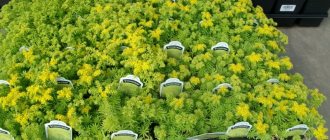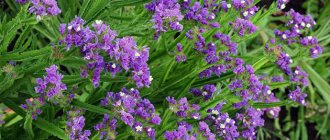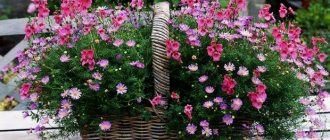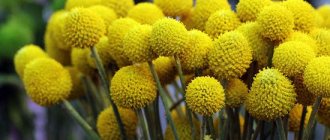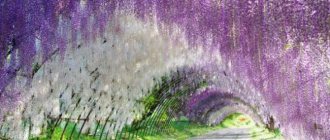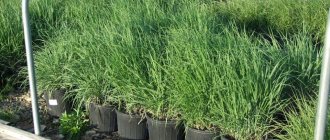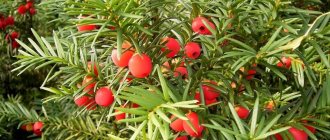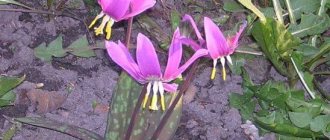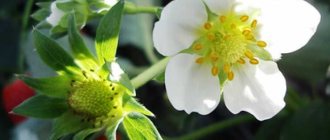Botanical description of sedum
Sedum is a herbaceous succulent from the Crassulaceae family.
Its life cycle is perennial or biennial. Sedum bushes are low. The shoots of Sedum are dense and fleshy. They bear petiolate-free thick oval or ovoid leaves. The leaf blades are either completely flat (disc-shaped) or swollen, like small cylinders. The leaves are arranged, the color of which can be green, gray or even pink, opposite or whorled.
In summer, and sometimes in autumn, the sedum begins to bloom. Its small star-shaped flowers are collected in umbrella inflorescences. The color of the inflorescences depends on the variety of Sedum. It can be pink, white, yellow, blue. The bent petals grow together into a narrow tube, from the center of which a bunch of long thin stamens and an ovary style peek out. The flowers have a pleasant smell.
Types and varieties of Sedum
Despite the large number of varieties of Sedum, several types and varieties are considered the most popular among gardeners. Let's get to know them.
Common Sedum
This species is perennial. The height of the shoots is 20-60 cm. The leaves are oval, flat, with serrated edges, sessile. Flowering begins at the end of July. A dense corymbose inflorescence appears at the top of the stem, consisting of numerous small stars with long stamens. This species is a good honey plant. Has varieties:
- “Matrona” - the height of the shoots reaches 60 cm, the leaves are blue-green with a reddish edge, the inflorescences are light pink.
- "Linda Windsor" - dark burgundy stems covered with dark red foliage, topped with dark red inflorescences.
Sedum Purple
The height of this perennial succulent varies from 20 cm to 60 cm. The rhizome is tuberous. Stems are straight, leafy. The leaves are arranged alternately. The leaves, 3-10 cm long, are flat and quite fleshy. The inflorescences are umbrella-shaped and pink.
Sedum White
The height of the bush is 20 cm. The stems are fleshy and drooping. The green leaves are cylindrical in shape. In autumn the leaves turn pinkish or red. Flowering begins in late spring. Snow-white flowers are collected in loose inflorescences, which are located on bare peduncles, the length of which is 10-15 cm.
Sedum Caustic
The stems of Sedum caustic are branched, rather thick, 10 cm high. The stems are densely covered with alternate oval flat leaves with jagged edges. The leaves are small, their maximum length is 6 mm. The peduncles are also quite short, topped with loose inflorescences with sessile buds of a golden yellow hue. This variety blooms in late spring - early summer.
Sedum False
The species is winter-hardy. Rhizome – long, creeping; stems are creeping. On the stem there are ovoid leaves with serrated or crenate edges located opposite. The inflorescence has the shape of an umbrella. Consists of numerous pink or red flowers.
Morgana sedum
It stands out for its long, creeping shoots that grow up to 1 meter. The leaves have an oval or round shape. The length of the light green leaves is about 2 cm, thickness – 5 mm. At the tops of the peduncles there are inflorescences in the form of a dense umbrella, consisting of 10-15 pink or purple buds.
Sedum Bent
One of the popular garden species. The shoots are lodging, covered with sharp leaves of a bluish-green hue. In spring, a bare peduncle appears, the top of which is crowned with a dense inflorescence of golden yellow color.
When the plant blooms (flowering period), flower shape
The flowering period is different for different types of sedum. This time is mainly from July to August, although some can bloom at the very beginning of summer, such as false sedum. Its flowers come in a wide variety of colors from cream to purple.
Also in early summer, sedum blooms. Its yellow flowers bloom on tall peduncles.
Sedum blooms in autumn from September to November.
The general range of colors of sedum of various varieties is white, yellow and pink of various shades and color saturation.
Small flowers are collected in corymbose, umbellate and paniculate inflorescences.
Description of the plant
Sedum or sedum (lat. Sedum) is a genus of perennial plants of the Crassulaceae family. This succulent occurs naturally on all continents of the Northern Hemisphere as a meadow weed. Sedum, depending on the species, has different heights, shapes, colors of leaves, flowers and usually creates low carpets, although some species reach a shoot height of 80 cm. Among the sedums there are shrubs and annuals. These are excellent plants for rock gardens and flower beds.
Sedum is unpretentious, tolerates poor soils and unsystematic care, is resistant to drought, prefers places where the soil is quite poor, and loves sunny positions.
The leaf blades range from gray-green to dark purple. Fleshy leaves of different sizes and different arrangements on the stem serve as water storage reservoirs and make sedums specialists in surviving drought. Most species grow in nature in dry rocky or sandy places, steppes, dunes, and poor soils.
Some types of sedum bloom in the fall. The flowers are star-shaped, usually five-petaled, white, yellow, pink or purple.
Autumn work to prepare for winter
Before the onset of cold weather, the above-ground part of the plants is cut to a height of 20 centimeters, the cut stems will be used as cuttings, the root system should be sprinkled with a mound of humus, in the spring the mound is raked, and the humus becomes spring feeding.
Sedum is a unique plant, it pleases the soul with its beauty and heals the body. For a long time, people have extended their lives with its help, which is why its popular name made it look younger.
In addition, the drug Biosed, which is sold in pharmacies, is not inferior to the extract of the legendary aloe in terms of effectiveness; sedum even treats oncology, such an amazing plant.
Multifaceted, and often for this reason unrecognizable, sedum is an ornamental and medicinal plant that can decorate a garden in any form. A succulent plant from the Crassulaceae family can look like a lush flowering bush or a creeping carpet of stems with dense, fleshy leaves of various colors.
Sedum will successfully mask flaws in the design of a garden plot or empty spaces in flower beds, grow beautifully on an alpine hill or serve as a decorative border near a house or along paths.
The main habitats of sedum in nature are zones with a temperate climate, so growing it in our latitudes is not difficult.
We invite you to familiarize yourself with what a chamomile flower is made of.
Reproduction of sedum
Sedum propagates easily and takes root quickly. There are several methods of reproduction with their pros and cons. We will look at each of them in order.
Propagation by cuttings
Cuttings are the simplest, fastest and most effective way to propagate sedum. Even the leaves that have fallen from the mother bush to the ground in the pot take root. By the way, they can also be taken for reproduction. But more often a part of the stem is used for this. You don’t have to use a sharp tool to separate a cutting or leaf—nothing bad will happen if you just break off the desired part of the plant.
There is no need to plant the cuttings right away. Let it sit for a couple of hours at room temperature - the cut should dry out. Then plant the cutting in a cup of soil or in a container if there are several of them. Do not bury the cuttings too deeply into the soil. There is no need to create greenhouse conditions and cover the top with film. Do not water frequently - young sedum may rot if left in wet soil for a long time. Ventilate the room with seedlings periodically.
In a couple of weeks the cutting will give roots. You will understand this by the appearance of new leaves on it. 2 weeks after the roots have formed, the young succulent can be transplanted into a permanent pot.
Growing sedum from seeds
You can sow seeds in spring or autumn. You can get planting material yourself, but it’s easier to purchase it in a store. Only freshly harvested seeds have good germination, so pay attention to the expiration date indicated on the package.
Prepare a shallow, wide container and fill it with soil consisting of sand and peat. Seeds should be sown on the surface, without being buried in the ground or sprinkled with soil on top. For this reason, the soil should be moistened before sowing. Also, in order to evenly distribute all the seeds throughout the container, they can be mixed with dry sand. Cover the container with film.
In open ground, sedum seeds undergo a process of natural stratification - they lie under the snow all winter at sub-zero temperatures. This speeds up their germination. At home, seeds also need stratification. To do this, place the container with the sown seeds in the refrigerator for 2 weeks.
After the stratification process, place the seeds on a well-lit windowsill. The room temperature should be above 18 °C. In a couple of weeks, the first shoots will appear, but the seeds will finally germinate in about a month and a half. When two clearly visible leaves appear on the sprout, it can be transplanted into a separate pot.
This may be interesting: Aloe is the green doctor
Root division
Some types of sedum (Common, prominent, red-spotted) are easily propagated by dividing the rhizome if they grow strongly. At the beginning of spring, remove the bush from the pot, shake off the soil and divide it into several parts so that each of them has growing points and buds. Treat the cut areas with fungicides or sprinkle with activated carbon. Wait a few hours for the cuttings to dry out before planting them in separate pots.
Features of growing sedum
The plant, which grows in nature on almost any soil, including stony and even rocky, does not require careful care. Its amazing ability to take root very quickly allows it to grow independently and expand its habitat, forming living carpets in the garden.
Sedum tolerates drought easily, prefers well-lit places and requires periodic loosening of the soil and weeding. These plants cannot resist weeds, with the exception of sedum, which releases substances into the soil that expel any weeds around their habitat.
Sedum is a perennial plant, although there are also one- and two-year-old varieties. In three to four years, sedums usually grow out and need to be transplanted to another place for rejuvenation.
The most adapted to temperate climates and wintering are the sedum varieties (caustic, recurved, white, prominent). Varieties such as Spanish, Siebold sedum, and Evers sedum require additional shelter, especially in cold winters or when there is little snow. These varieties will require “cosmetic” procedures in the spring in the form of pruning old shoots and fertilizing with fresh substrate.
Sedum in the house
Flowers are both annual and perennial, and evergreen specimens live in tropical latitudes. The latter often become indoor plants in our latitudes.
The lifespan of sedums directly depends on living conditions, primarily on lighting , as well as on compliance with watering . It is important to prevent root rotting due to excess moisture.
Most often grown in the house:
1. Morgan's sedum , also called Donkey's Tail. Sedum looks great suspended, with freely flowing shoots. The leaves of this species look like drops. The shoots resemble ropes, grow up to a meter long, and are very fragile. Small red flowers appear at the ends of the shoots, but only in long-lived sedums.
2. Red-colored sedum . Blooms yellow. Low-growing shoots with small leaves of rich green color.
3. Sedum Adolf . White flowers. The stem of young plants is straight; as they grow, they begin to bend and spread.
4. Weinberg's sedum . The leaves of this sedum grow from a rosette and are covered with a wax-like coating on top.
Flowering and growth
Sedum blooms at home infrequently - this is due to the lack of direct sunlight. For stimulation, it is useful to place the plant outside or on a balcony. Sedum blooms in summer . And in winter, the plant needs to rest.
On average, a flower grows several centimeters per season .
Lighting
For all its unpretentiousness, hare cabbage is a very light-loving plant . Sedums need direct sunlight all year round for successful growth. Good ventilation is equally important.
Temperature
In warm weather, it is useful to take the sedum out into the fresh air . In winter, sedum can withstand zero temperatures, but feels best at 8 - 12 degrees . If the room is hot in winter, the sedum stretches and the leaves turn pale. This is due to the lack of light in winter.
Soil and replanting
Sedums do not require a special environment. These plants survive even in empty mountain soils.
1. It is advisable to put drainage at the bottom of the pot.
2. The soil for planting can be prepared from turf, sand and leaf soil, mixing all this in equal proportions. The sand must be coarse-grained. The substrate should be loose for better drying.
do not need frequent replanting , since replanting can easily damage their root system. Flowerpots for young plants are changed every two years, old plants - every four years. Some species can only be replanted if absolutely necessary, due to the fragility of the plant.
Sedum rhizomes are horizontal, so the pots should not be deep.
After purchasing, the sedum needs to be replanted only if the pot in which it grows does not suit the plant: the flowerpot should be wide, but not deep.
Watering and air humidity
Hernia grass belongs to the Crassulaceae family; these plants have thick leaves that store moisture. Therefore, the plant does not need frequent watering . In warm weather, moderate watering is sufficient when the soil in the pot dries out. You can’t overwater a flower – its roots easily rot in wet soil conditions. In cold weather, it is enough to water the sedum once every 1.5 - 2 months.
There is no need for additional air humidification for purification.
Answers to readers' questions
- Plant lifespan
Sedum needs to be rejuvenated every 4-5 years by transplanting.
Sedum will not bloom if it doesn't get enough light. All his strength goes into stretching the long stems towards the light.
- Why do the leaves turn yellow (dry)?
Perhaps the plant does not have enough mineral fertilizers or it is growing in an insufficiently bright place.
- Flower care in winter
At this time, sedum does not require care; it overwinters in the ground.
Reproduction (growing)
Sedums can be propagated:
Seeds . You can plant sedum seeds in autumn and spring, in shallow boxes. Then you need to cover it - create greenhouse conditions. After several leaves appear, the bores are transplanted into a pot.
By cuttings . They are planted immediately in flowerpots.
Leaves. The leaves are placed on the soil, where they take 3 to 5 weeks to sprout roots.
Young sedums bloom at 2–3 years of age.
special pruning . But if a shoot or leaf has fallen off, you can put water on it and, after the roots appear, plant it.
Pests
Due to the thick skin of sedums, pests hardly touch them. The exception is root scale insects.
For prevention, you need to avoid overwatering.
Possible problems and their signs
If the leaves of a sedum begin to wrinkle , it means the flower does not have enough moisture .
If the leaves fall off and the flower stretches upward, the plant does not have enough light .
Sometimes leaves can fall off as a reaction to a flower transplant.
In indoor floriculture, caring for sedums is very simple. You can create a whole garden on the windowsill by growing several types of these unpretentious, but very beautiful plants.
Sedum ground cover
There are many of them in the wild; we are very familiar with sedum due to its bright yellow flowers and stars on the green carpet. White sedum is very similar to it - its flowers are white, Caucasian sedum, Kamchatka, false, thick-leaved, they are widely used in landscape design, they, growing very quickly, form a flower carpet that can hide unsightly areas of the garden.
Ground cover sedums bloom from July to September, winter well, and do not require pruning or covering.
Application of sedum
Since ancient times, sedum has found its use in many traditional medicine recipes.
Preparations based on its juice can cure such common skin diseases as acne, acne, warts, eczema and lichen. It can be found in many homeopathic medicines for the treatment of gastrointestinal diseases and blood pressure disorders. In folk medicine, there are a huge number of recipes based on sedum, designed to cure epilepsy, gangrene, body ulcers, hemorrhoids, as well as bone fractures and joint diseases. From this plant you can prepare healing teas, tinctures, ointments and make compresses.
Important! Shrubs do not need to be frequently transplanted to a new location. One transplant to a new flowerbed after 2-3 years is enough.
Sedum - garden care
Fever grass is often grown in the garden.
Gardeners love sedums for their unpretentiousness. These plants make amazing flowering carpets. You can plant hare cabbage in combination with other plants to create flower arrangements.
More often you can find these types of sedums:
The sedum is prominent. A plant with straight stems, over half a meter in height. The leaves are light green, the flowers are pink.
Sedum telephium. There are several subspecies with flowers ranging from pink-red to cream.
Caucasian sedum. Grows in a carpet of yellow star flowers. This species is characterized by increased resistance to cold.
Purple sedum. The leaves of the plant are dark in color with a purple tint. Flowers are bright pink.
Caustic sedum. Low bushes with bright yellow flowers.
Sedum prominent
The bush is up to 60 centimeters tall, the inflorescences on the tops of the stems are bright, pink in various colors , it blooms later, from mid-August until frost, in appearance it resembles purple sedum, it reproduces in the same ways.
Reproduction by Seeds
Make sure that the seeds you purchased have not lost their viability; read on the bag how long it takes to sow the seeds, and whether seeds from your own plot are suitable for sowing. It is better to sow the seeds in a box with soil, you can use a sprayer for watering, the soil is not washed away, and cover the box with glass until shoots appear. When the young plants hatch, the box is placed in the light and the glass is removed, greenhouse conditions are no longer required, the grown plants dive.
Reproduction by layering
Sedum roots form without contact with the soil, and if the stem is pressed to the ground and sprinkled, the plant will quickly take root ; it must be planted in a permanent place.
Reproduction by Cuttings
The plant takes cuttings very well, the cuttings quickly grow roots in water and soil, 90% of the cuttings take root.
Dividing the bush
The bush must be divided so that in each part there remains a small number of stems and part of the rhizome; parts of the bushes must be planted in a permanent place; during the spring and summer, the sedum will rejuvenate and bloom in the spring.
We must remember that when sowing with seeds we will get hybrids, and when propagating vegetatively (by cuttings, dividing the bush, layering), our young plants will be copies of the mother bush, the bush from which we took cuttings and layering.
Feeding and fertilizing the flower
You can feed sedum with compost or humus, the main thing is not to overdo it with fertilizer. For 1 square meter of planting, it is enough to add no more than 10 kg of compost soil.
Sedum needs to be fertilized in spring and autumn, especially if it grows in combination with other plants. This neighborhood can take away nutrients from the sedum, so autumn feeding will help it survive the winter safely.
When planting, the soil for sedum can be fertilized with ash and sprinkled with sand.
For flowering species, you can use mineral and organic fertilizers containing nitrogen, but in small quantities. It should be remembered that a high content of organic matter in the soil for sedum can impair its frost resistance.
Important! A large amount of fertilizing can negatively affect the flowering of sedum.
Transfer
A young plant needs replanting once every couple of years, an adult - once every 3-4 years. Sedum easily tolerates transplantation, so it can be transplanted at any time of the year and even during flowering. The main thing is to handle it carefully, because the stems of sedum are quite brittle, and the leaves tend to fall off with any careless touch. Before replanting, slightly moisten the soil.
At first, it is better to keep the transplanted bush in partial shade and not disturb it. The next watering is carried out only after the top layer of soil has completely dried 1 cm deep.
After replanting, the plant may shed its leaves. It's okay, this is normal, new ones will grow soon.
Pot
The root system of sedum is small, so a low, wide pot with drainage holes is ideal. It is not necessary to change it to a larger one every time you replant, because the plant’s roots develop slowly and do not take up much space. You need to put a layer of drainage on the bottom of the pot. It is desirable that it be expanded clay, but pebbles will do.
This may be interesting: Sansevieria (Sansevieria) - unpretentious perfection
Priming
Purchased soil for succulent plants is suitable for sedum. If desired, you can prepare it yourself. There are two suitable options:
- Mix 1 teaspoon each of leaf soil, turf soil and river sand. Add a small amount of brick pieces and charcoal.
- Mix 2 parts of peat, 1 part of rotted leaves, 1 part of sand.
Beneficial features
It is not for nothing that sedum acquired such popular names as young, tenacious and living grass.
The plant has been used since ancient times as an antimicrobial and analgesic.
In modern folk medicine, sedum is often used. Infusions are made on its basis. They are believed to help with heart disease, pulmonary failure, and problems with the digestive system (with the exception of gastritis and ulcers).
We can confidently say that sedum infusions tone the body and relieve fatigue.
We invite you to familiarize yourself with Derbennik medicinal properties and contraindications
But despite all the centuries-old fame of the medicinal properties of sedum, you should not self-medicate. Do not forget that many sedums are poisonous.
Anyone can decorate their garden with sedum. It is difficult to find a less capricious handsome man.
Pests and diseases
Sedum is a viable crop and rarely gets sick. Problems with the plant arise from improper cultivation or bad weather conditions.
Caterpillars on sedum
Frequent watering causes roots to rot, creating conditions for fungi to live. Sedum is treated for diseases with fungicides if the disease is in an early stage. It is useless to spray plants with an advanced disease; it is destroyed.
The vital activity of aphids, caterpillars, sawflies, weevils and other “lovers” of sedum harms the health of the plant. They control pests with insecticides: actellik, fitoverm.
Ground cover species of sedums
Let's start the story with low views. Their common feature is the presence of lodging stems. That is why the height of these plants does not exceed 10-30 cm. Often the shoots take root when they come into contact with the soil. As a result, over time a mat forms.
Hybrid sedum (Sedum hybridum) forms low (up to 10-15 cm high) loose mats. The leaves of this species, which persist in winter, are oblong, spatulate in shape. In the second half of June, numerous golden-yellow flowers appear, collected in a corymbose inflorescence. Flowering continues until July.
Spanish sedum (Sedum hispanicum) is a young but very pretty plant. It is believed that it lives for 1-2 years, but if you regularly take cuttings from plants, the lifespan of this species can be significantly increased. Spanish sedum forms dense, dense low mats, not exceeding 5-10 cm in height.
Numerous oblong-shaped small leaves of light green or bluish-red color are the main decoration of this plant. In June–July, loose inflorescences consisting of small white flowers appear. This is one of our most capricious species; in severe winters it can disappear. After all, this sedum grows on rocky mountain slopes, and besides, it especially likes limestone outcrops in the Caucasus and Balkans. But on the other hand, it gives abundant self-seeding, so there is always a chance that you will have Spanish sedum, no matter what.
False sedum (Sedum spurium) is a persistent species found on the rocks and alpine meadows of the Caucasus. Long creeping shoots form loose clumps up to 10-15 cm high. This species has fleshy rhombic leaves of a dark green or reddish color. The stems of false sedum are preserved in the winter, but the leaves may fall off during the winter.
In July–August, dense corymbose inflorescences appear, consisting of many flowers of pale pink or dark pink color. The color of flowers in varieties is more varied - white, pink, purple. Flowering is very abundant. There are many varieties obtained based on the natural species. Ruby Mantle is especially beautiful with greenish-red leaves edged with rich dark red and purple flowers. The Tricolor variety also looks impressive, its leaves have a creamy border that takes on a reddish tint in the sun.
Sedum acre is a surprisingly resilient evergreen plant found in steppes and dry light pine forests. By the way, it can often be found along railways. Sedum grows throughout Europe, Siberia, North Africa, and, of course, such an active plant simply could not help but emigrate to North America, where it is now becoming increasingly common.
If it were a little higher, it could be a real aggressor. But since this plant is very low (up to 5-10 cm in height), it can only compete seriously with other types of low sedums and other ground cover plants. This is due to the fact that sedum grows quickly and soon forms thick dense mats, and besides, the species is capable of mass self-seeding.
But nevertheless he is very cute. Against the background of fleshy dark green small ovoid leaves, numerous yellow flowers appear in mid-June (and in the south of Russia even earlier). This species blooms for a long time - more than a month. Sedum is a medicinal plant that has restorative and blood pressure-lowering properties, and is also used as a laxative. Please note: it should be used with caution - like many other medicinal plants, sedum is poisonous (its juice can cause burns). By the way, previously the juice of this sedum was an alternative to beets in getting a blush on the cheeks.
Sedum stoloniferum is a unique plant. Unlike other sedums, it is shade-tolerant. The only pity is that it is a “young plant,” although it often self-sows. In sedum, reddish-colored stems creeping along the ground can reach a length of up to 30 cm, but the plant does not exceed 10 cm in height.
We invite you to read: Measure seven times, or how to prune a pear
There are few thin, round leaves on the stem; however, due to the numerous shoots, this species forms dense, dense mats. The leaves remain in winter. In July, numerous light pink flowers appear, collected in loose inflorescences. Unlike most sedums, sedum does not tolerate drought well, especially if it is grown in an open sunny place.
Sedum reflexum is a spectacular evergreen plant throughout the year. The narrow, fleshy, bluish-green leaves closely spaced together are especially attractive in the comb form of this species. In June–July, yellow flowers appear, collected in dense inflorescences. The species is stable and grows well in open sunny areas with dry, poor soil.
Evers' sedum (Sedum ewersii) can now be found under the name Evers' sedum (Hylotelephium ewersii), a taller plant. The plant reaches a height of 20 cm. The arched long creeping stems have a reddish-brown tint. The bluish-green, round leaves are sparsely located on the stem.
The species does not form dense curtains. In July–August, pink flowers appear, collected in a loose inflorescence. The view is unpretentious. In nature, it is widespread in a variety of regions - from Siberia and Mongolia to Northern India. Recently, varieties derived from this species have appeared on the market; they bloom more profusely and are more compact.
Sedum in autumn: planting, care, design
Sedum is a perennial plant from the Crassula family.
It is distinguished by a strong, straight stem and fleshy leaves in which it stores water. Belongs to the category of succulents.
Thanks to the ability to store water in the leaves, it survives in extreme heat. Also, thanks to the fleshy leaves, it grows and blooms until frost. For its persistence, it is popularly called hare cabbage, and in the scientific world - sedum.
Buy sedum
Buy sedum telefium
Conditions for the growth of sedum
They cannot tolerate shade and grow only in the sun. In the shade, the sedum becomes distorted, its beauty disappears, it does not bloom. The sedum is decorated with a star-shaped, umbrella-shaped inflorescence on a straight, tall stem, which blooms in a lush head from July until the onset of cold weather.
Sedum is universal in terms of decorative beauty, it always looks wonderful, some varieties surprise with lush flowering, while others with curved, curly leaves.
Unpretentious - grows on any soil - rocky, clay, sandy. But it does not respond well to drought. Requires moist soil. If the soil is sandy loam, you need to dilute it with compost or humus. Blooms from August to mid-November, some varieties until December.
Sedum hybrid Oracle (Oracle)
False sedum Roseum
How to plant sedum correctly
In autumn, sedum is planted by dividing a bush that grows in the garden. In spring - by cuttings and seeds. However, until mid-October, you can plant seeds.
You need to choose a place for planting that is sunny and spacious. Only here it blooms profusely and for a long time; in the shade it quickly withers. Sandy loam soil is diluted with compost or humus.
Using the division method, sedums are propagated every five years. Dig the bush out of the ground and divide the root into parts, sprinkle the root sections with wood ash.
Fertilize the soil with organic matter - compost or humus. Make holes at a distance of 20 cm from each other and plant sedum roots in them. They will bloom in the second year.
Sedum prominent Herbstfreude (Sedum Herbstfreude)
Sedum telephium Red Cauli
How to care for sedum
The soil around the sedum needs to be weeded frequently. Only sedum is not afraid of weeds. Few people survive around him. Therefore, they are often used to frame flower beds. Other varieties require frequent weeding; they cannot cope with weeds.
Make sure the soil is always slightly moist. To do this, it needs to be watered periodically. Abundantly - during periods of severe drought. Sedum shoots are always shortened. If they grow, they lose their decorative appearance.
Withered shoots and stems are also cut off. In sedum with multi-colored leaves, the green stems are cut off, leaving the colored ones.
In the fall, fertilizing is carried out with complex mineral fertilizers, including nitrogen, since the sedum vegetation continues in the fall. You can feed the sedum with a diluted infusion of mullein in a ratio of 1:10.
Sedum Diamond (Sedum)
Sedum telephium Matrona
Should I prune sedum in the fall?
It is necessary to prune sedum for the winter. In the spring it is cut off anyway, so it makes no sense to leave the plant for the winter. Its stem may break off due to a large amount of snow. Also in winter, during the most extreme cold, the leaves freeze.
Therefore, sedum is cut immediately after the first frost to a height of 3 or 4 cm from the root. The cuts are covered with earth. If you decide to propagate by cuttings, then cut them 6 cm long. Root the cuttings in a soil substrate of soil, compost and sand and plant them in the garden in the spring.
Sedum prominent Herbstfreude (Sedum Herbstfreude)
Sedum Carl (Sedum Carl)
How to grow sedum with seeds
Let’s immediately make a reservation that it is better to plant sedum seeds in the ground in the spring. In the fall, the plant will not be able to grow and take root in the best way.
Some gardeners still plant until mid-October. But in this case, before planting from seeds, you should not grow seedlings, but immediately sow the seeds into the ground.
In spring, seedlings are first grown. Soil for seedlings consists of a mixture of garden soil, compost or humus and sand; pour the mixture into boxes and sow seeds into it.
Buy sedum prominent
Buy white sedum
Buy sedum telefium
Seeds are not used to propagate varietal sedum, since sedum is an easily pollinated plant, and by planting seeds you will not get a varietal plant.
After all, during pollination it will mix with other plants and will not be a varietal plant. Therefore, you can only propagate by seeds the usual species.
Seeds are purchased at the store or collected from plants in the garden. Then each seed is placed in compacted soil and covered with a thin layer of sand on top. After this, the soil must be moistened, covered with film and kept in a cool room for two weeks.
Next, the plant should grow in a room with temperatures up to + 20 C. Soil moisture should be controlled. Sedum seedlings are planted in the ground in May.
Kamchatka sedum Variegatum (Sedum Variegatum)
Hybrid sedum Purple Emperor (Sedum Purple Emperor)
What kind of soil does sedum like?
Sedum is unpretentious and grows in any soil. But most of all he loves moist soil and sun. Even in partial shade, the sedum will die.
Like any plant, sedum prefers a nutrient mixture that contains humus, compost and sand. Before planting, dig a hole 20 cm deep and 50 cm in diameter, add a nutrient mixture and plant the sedum in it.
Sprinkle with gravel, loosen and water and it will delight you with a lush head of inflorescences and beautiful flowering. If you want to achieve constant and luxurious flowering, then plant sedum in areas with a small amount of sand, but enriched with nutritious compost or humus.
Do not plant in heavy clay soils, as water may stagnate. If the soil on the site is like this, then dilute it with sand or fine gravel. If the stem of the sedum is bare, then transplant it to a place where there is a lot of light and sun.
False sedum Album Superbum (Sedum Album Superbum)
False sedum Purpurtepich (Sedum Purpurtepich)
Sedum in landscape design
The peculiarities of using sedum in landscape design are that different varieties are so different from each other that they are used for different types of landscaping.
The most popular sedums are those that bloom in white, purple and pink flowers. Such varieties are called decorative and are widely used in landscape design.
One of them is the Diamond variety. This is a tall shrub of 15 straight stems tightly adjacent to each other. They form beautiful lush, large inflorescences. The flowers are red, dark pink, bloom from August to mid-November. Planted on clubs, they go well with hostas, conifers and other green plants.
Variety Karl is a tall plant with long stems and beautiful flowering with lush caps of dark pink flowers. Their color becomes even richer in autumn. Florists love making bouquets with these flowers. They are very good in flower arrangements. They are planted in rock gardens, alpine slides, and mixo-borders.
Varieties Matrona, Stardust, Frosty Morn can be planted in single plantings and in various types of landscape design. Very frost-resistant.
The color is bright, the leaves are dense with a white coating, the flowers are large, lush, pale pink and white. Thanks to this combination and the bright green color of dense green leaves, they can decorate gardens in single plantings, and they can also be used to decorate flower beds, rocky gardens and alpine slides.
The September Flame variety is a crimson flower, frost-resistant, decorating the landscape until December. Bush up to 50 cm high. Leaves are green with a blue tinge. It looks wonderful against the background of dark pink buds. September blaze blooms from mid-September to late November. The best combination is with cereals and wildflowers.
Sedum Purpur Form (Sedum Purpur Form)
Sedum Eversa (Sedum)
Variety of species
There are more than five hundred species of this plant in the world and many more self-hybridized ones. We will not describe each of the types, for obvious reasons, but will simply list those that are the most popular and well-known in our country.
- Sedum prominent is an erect plant whose growth reaches 60 cm in height. The leaves are fleshy, light green, the flowers are of various shades of pink;
- Sedum telephium is a beautiful, shorter growing plant with unusual pink or red flowers and dark purple leaves;
- Sedum Ruby Glow is a hybrid of two types of sedum, tenacious and rocky, with purple leaves and umbellate burgundy flowers;
- Adolf's sedum is an abundant, branched shrub with thick, fleshy and fairly strong leaves of a flat-round shape. The flowering is white, hemispherical, lateral, reaches a length of 12-13 cm;
- Siebold's sedum is a beautiful, herbaceous perennial with round, light green and slightly red leaves at the edges. Most often used as an indoor culture;
- Sedum compact is a perennial with strong stems and leaves, oblong-ovate in shape, gray-green in color. It blooms in mid-summer with white flowers with a strong aroma;
- Linear sedum is a herbaceous, perennial plant that is capable of forming a dense turf, creeping, quickly rooting, with leaves of a light green hue. Flowering is umbellate, yellowish;
- Sedum Stahl - height no more than 20 cm, subshrub with few branched shoots, oblong leaves, ovate shape, color from red to brown. The peduncle is leafy, fairly branched, the inflorescence is paniculate, yellow.
Useful video
Watch a video about caring for Sedum in the garden:
https://youtu.be/yKZZXSWxvoE
If you find an error, please select a piece of text and press Ctrl+Enter.
—Categories
- = K U L I N A R I Y = (2404)
- Pancakes and pancakes (52)
- Dishes “KOREAN style” (76)
- Fruit and Berry Dishes (61)
- Baked pork, brisket, ham, pastrami, etc. (59)
- Sandwiches, canapés (46)
- Quick and Tasty LUNCH or DINNER (203)
- Quick and Delicious BREAKFAST (125)
- Dumplings, dumplings, khinkali, manti, etc. (51)
- Side dish (35)
- Stuffed cabbage rolls (14)
- Cooking in a sleeve, foil, etc. (73)
- Cooking in MICROWAVE (45)
- Cooking in a MULTICOOKER (30)
- We prepare for a HOLIDAY, FUCKET, etc. (149)
- Cooking OFF-PRODUCTS (tongue, liver, heart, etc.) (37)
- Cooking with MUSHROOMS (61)
- Dessert: sweets, ice cream, yoghurts, etc. (114)
- For a PICNIC (111)
- in KAZAN at KOSTRA (5)
- Food in pots (34)
- Deep-fry: pasties, belyashi, pies, etc. (77)
- Snack cakes and rolls (17)
- Blanks for future use (SEMI-FINISHED PRODUCTS) (23)
- Goldfish (98)
- Salt the fish (67)
- Casserole (22)
- Greens (9)
- From cheese. (23)
- From stale bread (17)
- From Eggs: dishes, omelettes, brizoli, etc. (35)
- We smoke products (27)
- Cereals. Porridge (16)
- Pockmarked hen (176)
- in LAVASH (60)
- Menu for the week (9)
- Seafood (12)
- Meat and minced meat (251)
- Drinks (67)
- Vegetables (136)
- Recipe from Stalik Khankishiev (16)
- SNACK rolls (58)
- Salads and snacks (325)
- Salo (39)
- YOUR OWN meatloaves, sausages, sausages, etc. (28)
- DIY (butter, cheese, etc.) (66)
- TIPS for cooking (97)
- Sauces, Marinades, Dressings, Gravy (50)
- Spaghetti, Pasta, Noodles (7)
- Soups, lagman, beshbarmak, etc. (37)
- We create from cottage cheese (107)
- Decorating dishes, carving (64)
- STUFFED vegetables, vegetable pancakes, pies, zrazy (64)
- Jellied meat, Jellied (7)
- Food storage (35)
- = BAKER A = (357)
- DOUGH (113)
- Puff pastry (44)
- The Beauty of BAKING (18)
- Bread, Flatbread, Donuts (16)
- Pies (75)
- Pies (65)
- Pizza (34)
- Samsa (5)
- And something else. (84)
- Baking TIPS (35)
- = S L A D E N K O E = (1954)
- DOUGH (89)
- The Beauty of BAKING (61)
- TIPS and IDEAS for baking (125)
- Puff pastry (69)
- From SHORT Dough (35)
- CREAM for decorating baked goods (36)
- glaze and fondant (24)
- MASTIC: cooking secrets (10)
- CAKES, sweet PIES (466)
- Cake on a FRYING PAN (33)
- Charlottes / Pies with fruits and berries (165)
- Cheesecakes, Flans, Tarts (66)
- Puff pastries, Croissants, Rolls, Buns (166)
- Cupcakes, Easter cakes, muffins, cupcakes (124)
- Manniki, Cottage cheese, Sour cream (41)
- Cakes, Gingerbread, Eclairs (111)
- Cookies, Gingerbread, Meringue, Shortcakes (225)
- Nuts, Donuts, Donuts, Bagels (52)
- Rolls (83)
- Sochni (6)
- Cheesecakes (12)
- Brushwood, baursaks, chak-chak (15)
- NO BAKE (267)
- Dessert (candies, bars, etc.) (123)
- Waffles (3)
- Collection of recipes (27)
- Confectionery equipment (10)
- = Z A G O T O V K I for Z I M U = (253)
- Important! (17)
- Freeze (26)
- Adjika, ketchup, sauces (20)
- Cucumbers, tomatoes, cabbage (58)
- Zucchini, eggplant, peppers, etc. (thirty)
- From fruits and berries (89)
- Salad for the winter (5)
- Greens (3)
- Mushrooms for the winter (24)
- = K U X N I = (209)
- TABLEWARE (use and care) (54)
- Putting the KITCHEN IN ORDER (64)
- OWN: liquid soap, sprays, etc. (22)
- Fridge. Microwave oven (care, unusual uses) (14)
- Kitchen FURNITURE (34)
- Useful in the KITCHEN (41)
- = U Y T in D O M E = (982)
- Bathhouse (23)
- We knit (socks, mittens and something else. ) (25)
- Hassle-free ironing (18)
- Decoupage and decor (298)
- We make furniture beautiful (covers, capes, etc.) (16)
- For the soul: decorating the house (and garden) with crafts (92)
- Let's tie a scarf and tie (26)
- Interior (108)
- Rugs (16)
- Something about FOOTWEAR (31)
- Beauty for walls (wallpaper, stencils, etc.) (50)
- OWN sprays, liquid soap, bleaches, etc. (39)
- Serving and etiquette (8)
- Cleaning WITHOUT chemicals (66)
- Smart cleaning (79)
- Chemical cleaning at home (90)
- Clean washing in a clean washing machine (104)
- = USEFUL - BAD TIPS = (163)
- Home Economics (77)
- Under the LAW (Family Matters) (48)
- Miscellaneous (42)
- Useful on the go (3)
- = CUT and SEW = (604)
- Building a PATTERN (30)
- TIPS for seamstresses (84)
- Blouses, tunics, cardigans, etc. (83)
- Dresses, robes, etc. (67)
- Pants, skirts (50)
- Lingerie and Swimwear (22)
- And something else. (5)
- Minor clothing repairs (19)
- Repurpose old things (75)
- Bed linen (25)
- Curtains (tailoring, collections) (112)
- Bags and wallets (41)
- Tips for chubby girls (98)
- From fabric scraps (27)
- = HOMEHOUSE = (1505)
- Gardener's CALENDAR (56)
- SEEDLING: soil mixtures, sowing and care (166)
- Review and characteristics of vegetable seeds and fruits (66)
- Fertilizers, Fertilizers, Growth stimulants (246)
- Tools, garden accessories (49)
- Greenhouses, greenhouses, beds (136)
- Watering (69)
- Useful tips for the garden (41)
- Tips from Igor Lyadov (6)
- Weeds, Pests, Plant Diseases (194)
- Tomatoes (338)
- Cucumbers (209)
- Onion and Garlic (139)
- Berry (131)
- Berry bushes (92)
- Orchard (93)
- Greens (10)
- Legumes and Other Vegetables (11)
- Bakhcha (38)
- Cabbage (25)
- Potatoes and Root Vegetables (73)
- Compost (17)
- Lawn (4)
- Mushrooms (5)
- Vegetable harvesting (1)
- Storing vegetables and fruits (22)
- = COLOR = (763)
- Sowing flowers for seedlings. Soil mixtures (99)
- Annuals (44)
- Biennial garden flowers (12)
- Perennials (sowing, care, propagation, advice) (77)
- Bulbous perennials (51)
- Lilies (22)
- Peonies (24)
- Phlox (10)
- Roses (118)
- Lianas (Clemates, Kobeya, etc.) (42)
- Ampelous flowers (103)
- Petunias (118)
- Eustoma (7)
- Fuchsia (23)
- Pelargonium (Geranium) (25)
- Shrubs in the garden (4)
- General tips for flower growers (55)
- Watering and fertilizing flowers (83)
- Flowerpots, pots. (38)
- Flower beds, flower beds, rock gardens (63)
- = M A S T E R A M = (482)
- We do it ourselves for home and garden (182)
- We make furniture (89)
- Remodeling and decorating old furniture (35)
- We will build a grill, barbecue, barbecue ourselves (36)
- About tiles and concrete blocks (23)
- We'll do the repairs ourselves (80)
- We repair equipment (7)
- Plumber (9)
- COLLECTION OF TIPS (20)
- Builder (54)
- Electrician (13)
- Fisherman (3)
- = HEALTH = (652)
- Sore feet . (47)
- Instead of tablets (healing properties of honey and plants) (97)
- Headache, Stroke, Heart Attack (3)
- Stomach and. etc. (12)
- Getting rid of BAD habits (32)
- Beauty is a terrible force (107)
- Did you call an ENT specialist?! (Ear, nose, throat) (34)
- We increase IMMUNITY (and cleanse the body a little). (48)
- Spine, neck and joints (126)
- Liver, Kidneys, Urinary. (26)
- Cold ? Yes . but it's NOT a TROUBLE! (56)
- DOCTOR'S advice (9)
- MISCELLANEOUS (People's Councils) (142)
- Tablets and ointments (57)
- = TIPS FOR PARENTS = (158)
- General Tips (90)
- For Schoolboy (72)
- = D E T Y M = (145)
- Games (85)
- Cartoons and films (64)
- = I N T E R E S N O = (1282)
- Rus, Russia, Russian language (11)
- Online (cinema and more) (140)
- WOW (WoW). (9)
- Age-old wisdom (25)
- Vesyolenkoe (349)
- Date of birth, names, horoscopes (70)
- For SMS and congratulations (48)
- BEAUTY (267)
- Music, songs (98)
- A little bit about everything (127)
- SUPER - dancing (61)
- Believe it or not, believe it or not. (86)
- = For D N E V N I K A = (111)
- "with Codes" (4)
- Anime and Decorations (7)
- Tips (24)
- Schemes (72)
- = ELECTRONIC LIBRARY = (7)
Rock garden
Stones combine very harmoniously and attractively with this plant, because in nature sedums grow mostly near stones and boulders; this successful composition was suggested by Mother Nature herself. An excellent solution would be to use sedum on a hillside, on an alpine hill, or simply on a flat area.
The sedum visible in late autumn looks very picturesque, a time when the beauty of the garden gradually begins to fade, but these plants can also boast of freshness and attractive appearance. And if you leave the sedum for the winter, you will be presented with a wonderful picture where green gnomes are still peeking out under the snow caps.
Sedum Care
Like any garden plants, Sedum needs a little care. It comes down to the following steps.
Weeding
Sedum really does not like being close to weeds, and therefore, if they appear, it is necessary to remove the weeds. The only exception is the Caustic Sedum variety, which independently copes with weeds.
Watering
Like most succulents, Sedum is able to accumulate a sufficient amount of moisture in its leaves, and therefore the plant only needs watering during severe drought. It is necessary to water carefully so that there is no stagnation of water, otherwise the plant may begin to rot.
Feeding
Sedum does not need regular feeding. A succulent can thrive in poor soil. Decorative forms can be fertilized. They should be fed twice – in spring (April) and autumn (September). It is enough to add half a portion of universal mineral fertilizer.
Trimming (haircut)
To keep the bushes looking neat, they should be trimmed regularly. In addition, it is necessary to remove dry shoots and wilted inflorescences. After 5 years, it is recommended to rejuvenate the Sedum bush.
Preparing for winter
In late autumn, when the air temperature drops significantly, the bush is pruned almost to the ground, leaving a stump of 3-4 cm. The bush is sprinkled with earth on top.
Diseases. Pests
Sedum is quite disease resistant. Only stagnation of water or excessive waterlogging of the soil can cause fungal infections - the leaves darken and acquire a putrid odor. It is urgent to remove the affected parts of the plant and treat the plantings with a fungicide.
Insects that can annoy a succulent are aphids, weevils, thrips, and caterpillars. Insecticides and acaricides will help get rid of pests.
